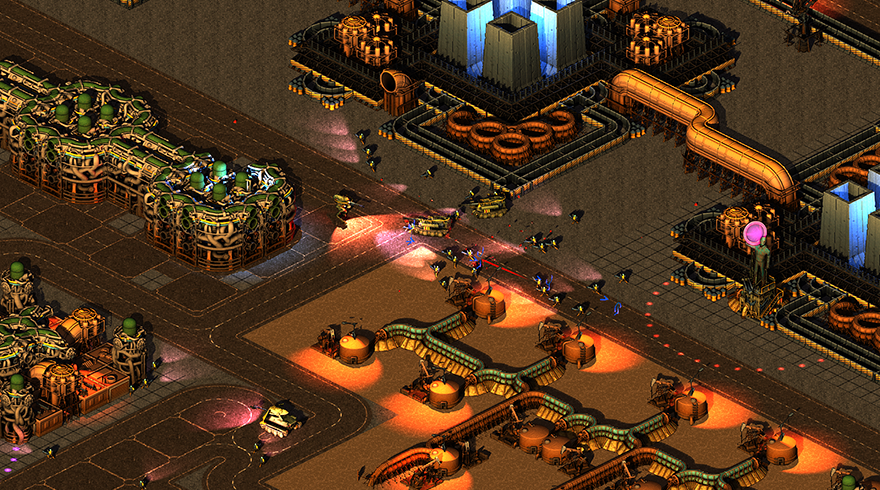Brigador wants you to die with dignity

Brigador was originally called Matador. Playing the game, recently released on Steam Early Access after many delays, it’s hard not to think of the original title’s allusions to bullfighting. The game places you inside a futuristic mech of your choice, drops you into arena-like isometric nightscapes, and tasks you with destroying enemy fighters and armaments in short-lived blazes of revolutionary madness. At first glance, surely I was playing an earth-stomping, industrial-strength matador, a noble killer taunting and teasing AIs around me. But as time went on, as my deaths racked up in one hellfire massacre after another, it became clear that I was the one being toyed with, stalked and preyed upon like a cornered bull.
“Bullfighting is a dramatic ritual in which death and the suffering of life find their ultimate poetic expression,” reported The New York Times in 2007, paraphrasing Pedrito de Portugal’s description of his craft. The fighter maneuvers the bull, he explained, leading a dance between the two of them through his agility and psychology rather than brute force.

The fights in Brigador are not so elegant. They’re scrappy, inexact, lumbering affairs. Part of this stems from the learning curve associated with the game’s tank controls. Piloting a mech in Brigador means turning its legs in the direction you want to move and accelerating backwards or forwards from there, all while rotating top-mounted guns along a 360-degree plane using the mouse.
It’s tough to negotiate at first, especially in the minutely textured labyrinths of destructible assets scattered throughout each level. Imagine a wounded bull who can’t charge in a straight line, veering off to the side, bashing its horns against the arena walls in its futile attempts to course-correct. Designing and programming a robot to walk on legs is notoriously difficult, and while Brigador’s mechs are all proven designs within the world of the game, the practiced sophistication needed to pilot them gives the game a dimension beyond the twitchy twin-stick shooters most people are familiar with.
The fights in Brigador are scrappy, inexact, lumbering affairs.
Everything in Brigador’s presentation seems to encourage an overly frenetic, trigger-happy approach. The pulsing synth music and neon lights give it the feel of a late-night bender. Its premise, battle against enemy factions for control of a city whose political leader has just died, all within a single night, suggests the need for reckless abandon over patient strategizing. And then there’s the random generation and placement of enemies, all but forcing the player to improvise on the fly, limiting one’s ability to master the flow of combat for any given level.
But giving into that impulse turns out to be a mistake. The game’s true poetry lies in how it lets the player explore new areas un-directed. Outside of the narrow objective of destroying massive ground canons controlled by the opposition, there’s nothing much to actually do (currently) in Brigador but wander around. I spent more time dodging squads of enemies through liberal use of a seconds-long cloaking ability and ducking into nearby forests or swamps than I did blowing them up. Sometimes it was enough just to concentrate on turning a corner or crashing through a highway barrier in retreat.

Brigador’s streets, pipelines, and shanty towns are etched onto a black canvas. In this way it feels like rummaging through the inside of an old Lite-Brite, if each little brightly colored bead of acrylic could be inoffensively crushed into nothingness. Beyond its unintuitive tank controls and unpredictable AIs, the game prides itself on the breadth of its destructibility. Any obstacle you encounter in the game can be destroyed, either by blasting it with one of your guns to punching the space bar to stomp on or ram it with your mech.
While this allows players to carve their own paths through Brigador’s detritus, it also provides game with tactile quality usually reserved for more committed walking simulators. The way Katherine Cross explained it for Gamasutra, a game’s heightened interactivity in this regard can be “essential to the kind of experience it is trying to create: one where the setting is the story.” Brigador’s world, narrowly defined as it is, comes into focus less through its frantic firefights than the seconds and minutes spent discovering finely drawn gas stations or graveyards, only to accidentally trample everything inside.
The game prides itself on the breadth of its destructibility
Each mech and weapon that can be selected in the game interacts with these environments differently. Some let you move faster or slower, and some break through walls and buildings more easily than others. In the end these parameters, the ones dictating how you can move through and interact with Brigador’s world, are far more important than the ones controlling how well you hold up in a street fight. Like bullfighting, it’s less about the art of the kill than the art of the struggle, because you will almost always die in Brigador, and when you don’t you’ll simply start again until you do.



